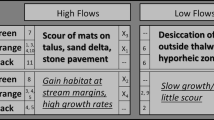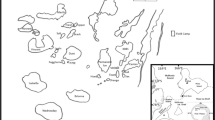Abstract
Microbial biofilms are biological hotspots in many alpine and polar ecosystems, but the controls on and functional significance of their fauna are little known. We studied cyanobacterial mats and the underlying sediment in a glacial meltwater stream in the McMurdo Dry valleys, Antarctica. We investigated mat biomass (total and phototrophic), diatoms, and micro-meiofauna (nematodes, rotifers, and tardigrades) at nine sites along a 1670 m stream reach in a cold, low-flow growing season, and in a warmer growing season in which peak flows (above 100 L s−1) scoured the mats. Diatom and invertebrate communities were not related, but mat biomass in the low-flow year was negatively related to nematode abundance, including that of the omnivore Eudorylaimus. In the high flow year that followed, invertebrate abundance was reduced in the mats, diatom community structure was altered, and mat biomass was higher. The difference in invertebrate abundance between years was greater in mats in upstream reaches, where the greatest increases in flow velocity may have occurred, and was negligible in mats in downstream reaches as well as in the sediment beneath the mats. Integrating our results with previous findings, we generate two predictive hypotheses to be tested in glacial meltwater streams: (1) under peak flows invertebrates decline in the microbial mats, while (2) the sediment beneath the mats is a refuge from the flow disturbance. Our results also suggest that, under stable flow conditions, microinvertebrate grazers could exert top-down control on microbial mat biomass.



Similar content being viewed by others
References
Adams BJ, Bardgett RD, Ayres E, Wall DH, Aislabie J, Bamforth S, Bargagli R, Cary C, Cavacini P, Connell L, Convey P (2006) Diversity and distribution of Victoria Land biota. Soil Biol Biochem 38:3003–3018. https://doi.org/10.1016/j.soilbio.2006.04.030
Adams BJ, Wall DH, Virginia RA, Broos E, Knox MA (2014) Ecological biogeography of the terrestrial Nematodes of Victoria Land, Antarctica. Zookeys 71:29–71. https://doi.org/10.3897/zookeys.419.7180
Arndt H (1993) Rotifers as predators on components of the microbial web (bacteria, heterotrophic flagellates, ciliates)—a review. Hydrobiologia 255–256:231–246. https://doi.org/10.1007/BF00025844
Barrett JE, Gooseff MN, Takacs-Vesbach C (2009) Spatial variation in soil active-layer geochemistry across hydrologic margins in polar desert ecosystems. Hydrol Earth Syst Sci Discuss 6:3725–3751. https://doi.org/10.5194/hessd-6-3725-2009
Battin TJ, Kaplan LA, Denis Newbold J, Hansen CME (2003) Contributions of microbial biofilms to ecosystem processes in stream mesocosms. Nature 426:439–442. https://doi.org/10.1038/nature02152
Borchardt MA, Bott TL (1995) Meiofaunal grazing of bacteria and algae in a piedmont stream. J N Am Benthol Soc 14:278–298. https://doi.org/10.2307/1467780
Cathey DD, Parker BC, Simmons GM, Yongue WH, Van Brunt MR (1981) The microfauna of algal mats and artificial substrates in Southern Victoria Land lakes of Antarctica. Hydrobiologia 85:3–15. https://doi.org/10.1007/BF00011340
Cavicchioli R (2015) Microbial ecology of Antarctic aquatic systems. Nat Rev Microbiol. https://doi.org/10.1038/nrmicro3549
Convey P, Chown SL, Clarke A, Barnes DK, Bokhorst S, Cummings V, Ducklow HW, Frati F, Green TG, Gordon S, Griffiths HJ (2014) The spatial structure of Antarctic biodiversity. Ecol Monogr 84:203–244. https://doi.org/10.1890/12-2216.1
Cullis JDS, Stanish LF, McKnight DM (2014) Diel flow pulses drive particulate organic matter transport from microbial mats in a glacial meltwater stream in the McMurdo dry valleys. Water Resour Res 50:86–97. https://doi.org/10.1002/2013WR014061
Vijver B, Beyens L, Lange-Bertalot H (2004) The genus Stauroneis in the Arctic and (sub-) Antarctic-regions. Bibl Diatomol 51:1–317
Derlon N, Koch N, Eugster B, Posch T, Pernthaler J, Pronk W, Morgenroth E (2013) Activity of metazoa governs biofilm structure formation and enhances permeate flux during gravity-driven membrane (GDM) filtration. Water Res 47:2085–2095. https://doi.org/10.1016/J.WATRES.2013.01.033
Epstein SS (1997) Microbial food webs in marine sediments. I. Trophic Interactions and grazing rates in two tidal flat communities. Microb Ecol 34:188–198. https://doi.org/10.1007/s002489900048
Esposito RM, Horn SL, McKnight DM, Cox MJ, Grant MC, Spaulding SA, Doran PT, Cozzetto KD (2006) Antarctic climate cooling and response of diatoms in glacial meltwater streams. Geophys Res Lett 33:L07406. https://doi.org/10.1029/2006GL025903
Esposito RM, Spaulding SA, McKnight DM, Van de Vijver BA, Kopalová K, Lubinski D, Hall B, Whittaker T (2008) Inland diatoms from the McMurdo dry valleys and James Ross Island, Antarctica. Botany 86:1378–1392. https://doi.org/10.1139/B08-100
Freckman DW, Virginia RA (1993) Extraction of nematodes from dry valley Antarctic soils. Polar Biol 13:483–487. https://doi.org/10.1007/BF00233139
Freckman DW, Virginia RA (1997) Low-diversity antarctic soil nematode communities: distribution and response to disturbance. Ecology 78:363–369. https://doi.org/10.1890/0012-9658(1997)078[0363:LDASNC]2.0.CO;2
Gaudes A, Muñoz I, Sabater S, Vilalta E (2006) The nematode community in cyanobacterial biofilms in the river Llobregat, Spain. Nematology 8:909–919. https://doi.org/10.1163/156854106779799169
Gooseff MN, McKnight DM, Runkel RL, Duff JH (2004) Denitrification and hydrologic transient storage in a glacial meltwater stream, McMurdo dry valleys, Antarctica. Limnol Oceanogr 49:1884–1895. https://doi.org/10.4319/lo.2004.49.5.1884
Grimm N, Petrone K (1997) Nitrogen fixation in a desert stream ecosystem. Biogeochemistry 37:33–61
Hillebrand H (2009) Meta-analysis of grazer control of periphyton biomass across aquatic ecosystems. J Phycol 45:798–806. https://doi.org/10.1111/j.1529-8817.2009.00702.x
Hogg ID, Cary SC, Convey P et al (2006) Biotic interactions in Antarctic terrestrial ecosystems: are they a factor? Soil Biol Biochem 38:3035–3040. https://doi.org/10.1016/j.soilbio.2006.04.026
Hughes WC (1980) Scour velocities in ephemeral channels. J Hydraul Div 106:1435–1441
Iakovenko NS, Smykla J, Convey P, Kašparová E, Kozeretska IA, Trokhymets V, Dykyy I, Plewka M, Devetter M, Duriš Z, Janko K (2015) Antarctic bdelloid rotifers: diversity, endemism and evolution. Hydrobiologia 761:5–43
Jungblut AD, Vincent WF, Lovejoy C (2012) Eukaryotes in Arctic and Antarctic cyanobacterial mats. FEMS Microbiol Ecol 82:416–428. https://doi.org/10.1111/j.1574-6941.2012.01418.x
Kagoshima H, Imura S, Suzuki AC (2013) Molecular and morphological analysis of an Antarctic tardigrade, Acutuncus antarcticus. J Limnol 72:15–23. https://doi.org/10.4081/jlimnol.2013.s1.e3
Kohler TJ, Kopalová K, Van De Vijver B, Kociolek JP (2015a) The genus Luticola D.G. Mann (Bacillariophyta) from the McMurdo sound region, Antarctica, with the description of four new species. Phytotaxa 208:103–134. https://doi.org/10.11646/phytotaxa.208.2.1
Kohler TJ, Stanish LF, Crisp SW, Koch JC, Liptzin D, Baeseman JL, McKnight DM (2015b) Life in the main channel: long-term hydrologic control of microbial mat abundance in McMurdo dry valley streams, Antarctica. Ecosystems 18:310–327. https://doi.org/10.1007/s10021-014-9829-6
Magalhães C, Stevens MI, Cary SC, Ball BA, Storey BC, Wall DH, Türk R, Ruprecht U (2012) At limits of life: multidisciplinary insights reveal environmental constraints on biotic diversity in continental Antarctica. PLoS ONE 7:e44578. https://doi.org/10.1371/journal.pone.0044578
Majdi N, Traunspurger W (2015) Free-living nematodes in the freshwater food web: a review. J Nematol 47:28–44
Majdi N, Mialet B, Boyer S, Tackx M, Leflaive J, Boulêtreau S, Ten-Hage L, Julien F, Fernandez R, Buffan-Dubau E (2012) The relationship between epilithic biofilm stability and its associated meiofauna under two patterns of flood disturbance. Freshw Sci 31:38–50. https://doi.org/10.1899/11-073.1
McKnight DM, Niyogi DK, Alger AS, Bomblies A, Conovitz PA, Tate CM (1999) Dry valley streams in Antarctica: ecosystems waiting for water. Bioscience 49:985. https://doi.org/10.2307/1313732
McKnight DM, Tate CM, Andrews ED, Niyogi DK, Cozzetto K, Welch K, Lyons WB, Capone DG (2007) Reactivation of a cryptobiotic stream ecosystem in the McMurdo dry valleys, Antarctica: a long-term geomorphological experiment. Geomorphology 89:186–204. https://doi.org/10.1016/j.geomorph.2006.07.025
Mialet B, Majdi N, Tackx M, Azémar F, Buffan-Dubau E (2013) Selective feeding of bdelloid rotifers in river biofilms. PLoS ONE 8:e75352. https://doi.org/10.1371/journal.pone.0075352
Neury-Ormanni J, Vedrenne J, Morin S (2016) Who eats who in biofilms? Exploring the drivers of microalgal and micro-meiofaunal abundance. Bot Lett 163:83–92. https://doi.org/10.1080/23818107.2016.1151827
Niederberger TD, Sohm JA, Gunderson TE, Parker AE, Tirindelli J, Capone DG, Carpenter EJ, Cary SC (2015) Microbial community composition of transiently wetted Antarctic dry valley soils. Front Microbiol 6:1–12. https://doi.org/10.3389/fmicb.2015.00009
Oksanen J, Blanchet FG, Kindt R, Legendre P, O’hara RB, Simpson GL, Solymos P, Stevens MH, Wagner H (2015) vegan: community ecology package. R package version 2-2
Paerl HW, Pinckney JL, Steppe TF (2000) Cyanobacterial-bacterial mat consortia: examining the functional unit of microbial survival and growth in extreme environments. Environ Microbiol 2:11–26. https://doi.org/10.1046/j.1462-2920.2000.00071.x
Pinheiro J, Bates D, DebRoy S, Sarkar D (2014) nlme: linear and nonlinear mixed effects models. R package version 3.1-117
R Core Team (2016) R: a language and environment for statistical computing. R Foundation for Statistical Computing, Vienna
Rautio M, Vincent WF (2006) Benthic and pelagic food resources for zooplankton in shallow high-latitude lakes and ponds. Freshw Biol 51:1038–1052. https://doi.org/10.1111/j.1365-2427.2006.01550.x
Rott E, Cantonati M, Füreder L, Pfister P (2006) Benthic algae in high altitude streams of the Alps—a neglected component of the aquatic biota. Hydrobiologia 562:195–216. https://doi.org/10.1007/s10750-005-1811-z
Sabbe K, Verleyen E, Hodgson DA, Vanhoutte K, Vyverman W (2003) Benthic diatom flora of freshwater and saline lakes in the Larsemann Hills and Rauer Islands, East Antarctica. Antarct Sci 15:S095410200300124X. https://doi.org/10.1017/S095410200300124X
Schmid-Araya JM, Hildrew AG, Robertson A, Schmid PE, Winterbottom J (2008) The importance of meiofauna in food webs: evidence from an acid stream. Ecology 83:1271–1285
Shaw EA, Adams BJ, Barrett JE, Lyons WB, Virginia RA, Wall DH (2018) Stable C and N isotope ratios reveal soil food web structure and identify the nematode Eudorylaimus antarcticus as an omnivore–predator in Taylor valley, Antarctica. Polar Biol. https://doi.org/10.1007/s00300-017-2243-8
Simmons BL, Wall DH, Adams BJ, Ayres E, Barrett JE, Virginia RA (2009) Terrestrial mesofauna in above- and below-ground habitats: Taylor valley, Antarctica. Polar Biol 32:1549–1558. https://doi.org/10.1007/s00300-009-0639-9
Smykla J, Iakovenko N, Devetter M, Kaczmarek Ł (2012) Diversity and distribution of tardigrades in soils of Edmonson Point (Northern Victoria Land, continental Antarctica). Czech Polar Rep 2:61–70
Stanish LF, Nemergut DR, McKnight DM (2011) Hydrologic processes influence diatom community composition in dry valley streams. J N Am Benthol Soc 30:1057–1073. https://doi.org/10.1899/11-008.1
Stanish LF, Kohler TJ, Esposito RM, Simmons BL, Nielsen UN, Wall DH, Nemergut DR, McKnight DM (2012) Extreme streams: flow intermittency as a control of diatom communities in meltwater streams in the McMurdo dry valleys, Antarctica. Can J Fish Aquat Sci 69:1420–1432. https://doi.org/10.1139/f2012-046
Stanish LF, O’Neill SP, Gonzalez A, Legg TM, Knelman J, McKnight DM, Spaulding S, Nemergut DR (2013) Bacteria and diatom co-occurrence patterns in microbial mats from polar desert streams. Environ Microbiol 15:1115–1131. https://doi.org/10.1111/j.1462-2920.2012.02872.x
Tsujimoto M, Suzuki AC, Imura S (2015) Life history of the Antarctic tardigrade, Acutuncus antarcticus, under a constant laboratory environment. Polar Biol 38:1575–1581. https://doi.org/10.1007/s00300-015-1718-8
Tytgat B, Verleyen E, Obbels D, Peeters K, De Wever A, D’hondt s (2014) Bacterial diversity assessment in antarctic terrestrial and aquatic microbial mats: a comparison between bidirectional pyrosequencing and cultivation. PLoS ONE 9:e97564. https://doi.org/10.1371/journal.pone.0097564
Varin T, Lovejoy C, Jungblut AD, Vincent WF, Corbeil J (2010) Metagenomic profiling of Arctic microbial mat communities as nutrient scavenging and recycling systems. Limnol Oceanogr 55:1901–1911. https://doi.org/10.4319/lo.2010.55.5.1901
Vincent WF, James MR (1996) Biodiversity in extreme aquatic environments: lakes, ponds and streams of the Ross Sea sector, Antarctica. Biodivers Conserv 5:1451–1471. https://doi.org/10.1007/BF00051987
Vincent WF, Quesada A (2012) Cyanobacteria in high latitude lakes, rivers and seas. In: Ecology of cyanobacteria II: their diversity in space and time
Wall DH (2007) Global change tipping points: above- and below-ground biotic interactions in a low diversity ecosystem. Philos Trans R Soc Lond B Biol Sci 362:2291–2306. https://doi.org/10.1098/rstb.2006.1950
Zakhia F, Jungblut AD, Taton A, Vincent WF, Annick W (2008) Cyanobacteria in Cold Ecosystems. Psychrophiles from Biodivers to Biotechnol. Springer, Berlin, pp 121–135. https://doi.org/10.1007/978-3-540-74335-4_8
Zuur AF, Ieno EN, Elphick CS (2010) A protocol for data exploration to avoid common statistical problems. Methods Ecol Evol 1:3–14. https://doi.org/10.1111/j.2041-210X.2009.00001.x
Acknowledgements
We thank Uffe Nielsen, Karen Seaver and Tracy Smith for helping with sampling and invertebrate identification, and Eric Parrish for updating the field site map. This research was conducted as part of the McMurdo dry valleys Long Term Ecological Research project, NSF OPP Grants 9211773, 9810219 and 1115245. Geospatial support for this work was provided by the Polar Geospatial Center under NSF OPP awards 1043681 and 1559691. Comments by three anonymous reviewers helped us improve the text.
Author information
Authors and Affiliations
Corresponding author
Ethics declarations
Conflict of interest
The authors declare that they have no conflict of interest.
Electronic supplementary material
Below is the link to the electronic supplementary material.
Rights and permissions
About this article
Cite this article
Andriuzzi, W.S., Stanish, L.F., Simmons, B.L. et al. Spatial and temporal patterns of microbial mats and associated invertebrates along an Antarctic stream. Polar Biol 41, 1911–1921 (2018). https://doi.org/10.1007/s00300-018-2331-4
Received:
Revised:
Accepted:
Published:
Issue Date:
DOI: https://doi.org/10.1007/s00300-018-2331-4




